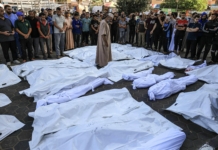Huge crowds of pilgrims started praying on Saudi Arabia’s Mount Arafat early on Friday, the high point of the biggest Haj pilgrimage since the pandemic forced drastic cuts in numbers for two years in a row.
The worshippers, capped at 1 million, including 850,000 from abroad chosen by lottery, spent the night at camps in the valley of Mina, seven kilometres from Makkah’s Grand Mosque.
In the early hours of Friday, they converged on Mount Arafat, where Prophet Muhammad (PBUH) delivered his final sermon, for the most important of the Haj rituals. They stayed all day at the site, praying and reciting the Holy Quran.
On this occasion, Dr Al Sheikh Muhammad bin Abdul Karim Al Issa delivered the Haj sermon, urging the entire Muslim world to be united for the supremacy of Islam and deal with the prevailing challenges with concerted efforts. The Muslims should follow the divine commands in letter and spirit to uphold the respect and dignity of Muslim community, he added.
After sunset, they headed to Muzdalifah, halfway between Arafat and Mina, where they slept under the stars before performing the symbolic “stoning of the devil” ceremony today (Saturday). This year’s Haj is taking place against the backdrop of a resurgence of Covid-19 in the region, with some Gulf countries tightening restrictions to keep outbreaks in check.
All participants were required to submit proof of full vaccination and negative PCR tests. Upon reaching Mina on Thursday, they were handed small bags containing masks and sanitisers.
The Haj, usually one of the world’s largest annual religious gatherings, is among the five pillars of Islam and must be undertaken by all Muslims with the means at least once in their lives.
In 2019, some 2.5 million Muslims from around the world took part, as in previous years.
But the coronavirus outbreak has since forced Saudi authorities to dramatically downsize the Haj. Just 60,000 fully vaccinated citizens and residents of the kingdom participated in 2021, up from a few thousand in 2020.
The pilgrimage can be physically draining even in ideal conditions, but worshippers this year have faced an added challenge: scorching sun and temperatures rising to 42 degrees Celsius.
Islam forbids men from wearing hats once the rites start, and many have been seen shielding themselves with umbrellas, prayer mats and even, in one case, a small bucket filled with water.
Women, meanwhile, are obliged to cover their heads with scarves. On the mountain Friday morning, many of the worshippers wept as they prayed, and carried umbrellas in preparation for the high temperatures later in the day.
Extreme conditions
“We can tolerate (the heat). We are here for the Haj. The more we tolerate, the more our pilgrimage is accepted,” Laila, a 64-year-old Iraqi pilgrim who gave only her first name, told AFP in Makkah before reaching the mount.
Saudi officials have touted their preparations for the extreme conditions, highlighting the hundreds of hospital beds allocated for heatstroke patients and the “large number of misting fans” they have provided. A truck has also been allocated to distribute umbrellas, water bottles and small fans.
Nevertheless, the National Centre for Meteorology, which has set up an office in Mina, is sending warnings to pilgrims on their mobile phones, urging them to avoid outdoor rituals at certain times of the day, especially at noon. On Saturday, pilgrims will take part in the “stoning”, the last major ritual of this year’s Haj.
This ritual has in past years led to deadly stampedes, as hundreds of thousands of participants converge on a small space.
After the stoning ritual, pilgrims return to the Grand Mosque in Makkah to perform a final “tawaf” or circling of the Kaaba. Eidul Azha marks the end of Haj.







